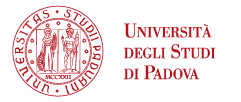PRIN 2022 PNRR / Loregian

Titolo: Dissecting the crosstalk between infected and bystander cells during human cytomegalovirus and Zika virus infection to discover novel pathogenetic mechanisms and therapeutical targets
Codice Progetto: P20222YKP8
Responsabile scientifico: Prof.ssa Arianna Loregian
Coordinatore: Università degli Studi del PIEMONTE ORIENTALE "Amedeo Avogadro"-Vercelli - Prof.ssa Marisa GARIGLIO
Partner-Unità di ricerca: Università degli Studi di PADOVA -Università di PISA
Bando: PRIN 2022 PRIN - Decreto Direttoriale n. 1409 del 14-09-2022
Durata: 01/12/2023 - 01/12/2025 (24 mesi)
Finanziamento progetto: € 239.394,00
Abstract del progetto
HCMV (human cytomegalovirus) is a human beta-herpesvirus usually acquired during childhood that establishes a lifelong persistent infection. However, in immunocompromised individuals, HCMV behaves like an opportunistic pathogen that can cause life-threatening disease. It is also a leading cause of birth defects, primarily affecting the central nervous system (CNS) upon congenital infections. Similarly, congenital Zika virus (ZIKV) infections are associated with severe congenital anomalies, given that it is an RNA virus transmitted by Aedes mosquito or from mother to fetus that particularly targets neural progenitor cells. Despite this evidence, the effects of these two neurotropic viruses on neural stem/progenitor cells and neighbouring bystander uninfected cells have been poorly investigated. Since both viruses impair neurogenesis upon congenital infection, we hypothesize that they display common pathogenetic mechanisms. Recently, it has been found that both DNA or RNA viruses can evoke a form of cellular senescence defined virus-induced senescence (VIS). Cellular senescence is a state of stable cell cycle arrest associated with acquisition of the senescence-associated secretory phenotype (SASP) that in turn switches paracrine senescence in the neighboring cells. The proposing team has recently demonstrated that HCMV-infected renal primary tubular cells but not fibroblasts are capable of triggering a senescence/inflammatory loop that leads bystander non-infected cells to develop a similar senescence/inflammatory phenotype. These findings raise the intriguing possibility that HCMV-mediated paracrine senescence of epithelial cells may contribute to HCMV-related pathogenesis in the kidney and very likely other organs. In this proposal, we aim to address whether VIS and paracrine senescence in bystander uninfected cells are also involved in the development of the brain disorders evoked by HCMV or ZIKV congenital infection. An essential element of innovation in this proposal is the use of stem cell-derived brain organoids that recapitulate the developing human brain architecture, with different cell types arising over the course of organoid maturation.
This proposal aims to: i) understand whether senescence and paracrine senescence, as an indirect amplifying mechanism of virus-induced damage, may also be envisaged for other HCMV-susceptible cell types, e.g. respiratory epithelial cells or cells of the neural lineage; ii) mechanistically dissect HCMV- and ZIKV-induced pathogenesis in the developing brain; and iii) molecularly and functionally characterize the crosstalk between infected and uninfected bystander cells. As targeting virus-induced senescent cells using senolytic drugs is an attractive option to selectively eliminate infected or damaged cells to create a more tolerant host response with reduced inflammation and disease, this proposal holds great potential to inspire the development of novel antiviral strategies.





